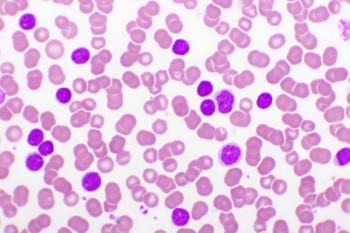
Real-World Findings Confirm Clinical Data on Momelotinib in MF With Anemia
Key Takeaways
- Real-world data on momelotinib shows improved hemoglobin levels and transfusion independence in MF patients with anemia, surpassing previous clinical trial results.
- By six months, 45.7% of patients achieved transfusion independence, exceeding the MOMENTUM trial's 27% benchmark.
The results offer some of the first glimpses into real-world findings of the Janus kinase inhibitor in patients with myelofibrosis (MF) and anemia.
Real-world insights on momelotinib (Ojjaara; GlaxoSmithKline) in patients with
The results offer some of the first glimpses into real-world findings of the Janus kinase (JAK) inhibitor, which
“This study presents the largest real-world cohort of MF patients treated with momelotinib and is the first to apply the recently proposed 2024 criteria for anemia response,” wrote the researchers, publishing the insights in
The retrospective study included 122 patients with MF and anemia across multiple treatment centers. Patients had disease-related symptoms or symptomatic splenomegaly and could be JAK-naive (23.4%) or previously received treatment with a JAK inhibitor (76.6%).
At treatment initiation, 73.8% of patients were dependent on transfusions. Among these patients, the median Hb level increased from 7.7 g/dL (range, 4.7-9.8) at treatment initiation to 8.7 g/dL at 3 months of follow-up. By 6 months, 30.6% of patients had major responses and 36.1% had minor responses. At the time follow-up point, median red blood cell transfusion frequency had dropped from 4 units per month to 1 unit per month.
Among the remaining patients who were not dependent on transfusions at treatment initiation, the median Hb level increased from 8.9 g/dL (range, 7.2-10.8) to 10.2 g/dL. At 6 months of follow-up, 36.4% of patients demonstrated a major response, and 27.3% demonstrated a minor response.
By 6 months, 45.7% of the patients included in the study, dubbed MOMGEMFIN, were transfusion independent, a notable increase in the proportion of patients achieving the benchmark in the pivotal MOMENTUM trial (NCT04173494).
In the MOMENTUM trial, transfusion independence was achieved among 27% of symptomatic patients with myelofibrosis and anemia who had previously received treatment with a JAK inhibitor. The
Spleen response observed in MOMGEMFIN, according to the 2013 ELN (IWG-MRT) criteria, was 24.4%, consistent with the rate seen in MOMENTUM and significantly higher than the rate seen in the SIMPLIFY-2 trial (9%). Median reduction in the real-world study was 10 cm (range, 6-15 cm). Nearly all (94%) patients reported disease-related symptoms at the start of the study, 92% of which had improvements after treatment. Improvements included a 76% reduction in asthenia, a 65% reduction in anorexia, a 51% reduction in weight loss, a 47% reduction in stomach discomfort, and a 75% reduction in pruritus.
Safety signals observed in the clinical trials were consistent in this real-world study, with diarrhea and infections being the most common nonhematologic side effects. Rates of peripheral neuropathy were similar in MOMGEMFIN and MOMENTUM (4.8% and 4%, respectively). Notably, rates of peripheral neuropathy were significantly higher in the SIMPLIFY-1 and SIMPLIFY-2 (NCT02101268) studies (13% and 11%, respectively).
Grade 3 or higher thrombocytopenia was reported in 6.2% of patients in MOMGEMFIN, similar to the 7% rate observed in SIMPLIFY-1 and significantly lower than the 28% rate observed in MOMENTUM.
“Importantly, most patients with thrombocytopenia maintained stable platelet counts during treatment,” noted the researchers.
Other hematological side effects observed in MOMGEMFIN included anemia and neutropenia.
References
- Pérez-Lamas L, Diaz AS, Delgado RG, et al. Real-world outcomes of momelotinib in myelofibrosis patients with anemia: results from the MOMGEMFIN study. Blood Cancer J. Published online April 17, 2025. doi:10.1038/s41408-025-01275-z
- McNulty R. FDA approves momelotinib for myelofibrosis with anemia. The American Journal of Managed Care®. September 15, 2023. Accessed May 1, 2025.
https://www.ajmc.com/view/fda-approves-momelotinib-for-myelofibrosis-with-anemia - Verstovsek S, Gerds AT, Vannucchi AM, et al. Momelotinib versus danazol in symptomatic patients with anaemia and myelofibrosis (MOMENTUM): results from an international, double-blind, randomised, controlled, phase 3 study. Lancet. 2023;401(10373):269-280. doi:10.1016/S0140-6736(22)02036-0
- Mesa RA, Kiladjian J-J, Catakano JV, et al. SIMPLIFY-1: A Phase III randomized trial of momelotinib versus ruxolitinib in Janus kinase inhibitor–naïve patients with myelofibrosis. J Clin Oncol. 2017;35(34):3844-3850. doi:10.1200/JCO.2017.73.4418
Newsletter
Stay ahead of policy, cost, and value—subscribe to AJMC for expert insights at the intersection of clinical care and health economics.









































